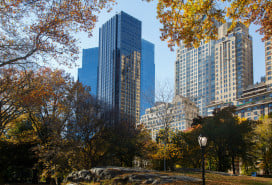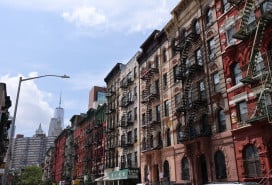10 things to look out for when you tour a rental apartment in NYC

Water pressure, nearby noise, and outlets are all things you might want to pay attention to.
iStock
Monthly rent, apartment size, and neighborhoods aren’t the only things that matter when you’re looking for an apartment in New York City. Making sure that the appliances work, your stuff fits, and you’ll have enough outlets are also essential things to take into consideration before signing a lease on a new apartment.
As you start touring available rentals to find The One, here are a few things you’re going to want to be on the lookout for.
[Editor’s note: An earlier version of this post was published in May 2016. We have updated it with new information for April 2019.]
1. Inspect the water pressure
Turn on the showers and sinks to make sure there's decent water pressure so your morning showers will, you know, actually get you clean. And be sure to flush the toilet, too. People usually don’t check these things until they move in, and by then it can be too late.
Michael Minarik, an agent at Mirador Real Estate, had a client lose out on an apartment because she was traveling and refused to take the place until she'd checked out its water pressure (she’d had problems with it in previous NYC apartments). By the time she got back to the city, the place was gone.
"Now in every apartment I go into, I tell people to check the water pressure—every faucet, sink, and toilet,” he says.
2. Check out common spaces
Are the building’s entryway, lobby, elevators, stairways, and hallways clean and well-maintained? Is garbage piling up in or around the garbage area? A building that is tidy is easy to spot, and having a live-in super helps.
"People assume that buildings have live-in supers but often they don't," says Eric Rohe, an agent at Halstead. "Be sure to ask."
3. Take measurements
To avoid a moving-day meltdown, make sure everything you own fits through the apartment’s front door, hallway, around any corners, and in its rooms. Have a notebook or note-taking app handy, and write down the measurements of your furniture before visiting an apartment.
"Sometimes apartments have strange layouts; you want to make sure the dimensions work for what you have already," says Rohe.
Take a tape measure, and yes, if you’re tech-savvy, there’s an app for that. The Measure app comes standard on Apple’s iOS 12 on certain iPhones and iPads, but unlike using the old-school way, Apple says to “make sure you’re in a place with good lighting.” Google Play has the Ruler App, and Air Measure is available on iOS and Android.
4. Test out the kitchen
Don’t be shy about fiddling around in the kitchen. Open the fridge and freezer to see how much space is inside, if both are cold enough, or if there’s any frost build up in the freezer. Turn on the stove and oven, too (just don’t forget to turn them off!).
"Give it a couple of minutes and see that the oven heats up. Make sure the burners on the stove work, too," says Rohe. "I was just showing an apartment and the client was a chef—she wanted to make sure that the oven works and the fridge was cold."
Sometimes, the landlord will replace old appliances when a new lease starts, so you might want to ask about that.
5. Scope out outlets & locate lights
This is something you likely won’t even think about until you’re surrounded by unpacked boxes with a plug in your hand. When looking around a potential apartment, take note of where—and how many—outlets there are in each room. (This will be easier to assess if you’re looking at an empty apartment, so you may need to do some sleuthing if the apartment is furnished.) Another thing you might want to do is take a phone charger with you to test some or all of the outlets.
Use a hair dryer or other accessories in the bath? Make sure there’s an outlet in there, which, surprisingly, is not a standard feature for all city apartments, especially older buildings as this writer found out in her last apartment, where she had to run two extension cords from the kitchen to use her hair dryer (a practice she soon abandoned after moving in).
This may seem like a no-brainer, but learn from this real-life example of why you should pay close attention to lighting: On move-in day, this writer was surprised to find that there were no overhead lights in the living room or bedroom, something she didn’t notice when checking the apartment out.
6. See the signal situation
It’s a good idea to make a cellphone call and see if there’s a wifi signal you can connect to.
"A lot of the most expensive apartments in luxury buildings are on the highest floors, and they can have bad phone reception," says Minarik.
Similarly, city apartment walls are filled with pipes, plumbing, bricks, and cement—aka things that can hinder a wifi signal. If you love the apartment you’re looking at, but are having trouble connecting, don’t fret: There are a few ways to make your wifi signal better in your NYC apartment.
7. Keep an ear out for noise
Noise tolerance is a very personal issue, and can depend on how much you plan to be in the apartment—and when. If you can, visit the apartment during the day and at night, advises Rohe. This way, you might be able to get a small sense of everyday—and neighborly—noises.
If you work from home, you may want to visit the apartment during the day to see what sort of activity there is, both in the building and on the street. If you have a pet who scares easily, you might want to be further from the elevator and common areas where there's a lot of foot traffic. If there’s a school, park, playground, or construction site nearby, you can bet there’s going to be a lot of noise in the daytime hours.
Visiting during the evening will help you gauge how loud restaurants and bars in the area are—and whether they will impact your sleep.
It’s important to get a good picture of what you are getting into, since breaking your lease because of a noise isn’t easy to do.
8. Open the closet
New York City apartments aren't known for tons of closet space—and some bedrooms don’t even have one—so you might need to get creative (think clothes racks and under-bed storage). Ask if the building has a storage room or consider leasing storage space elsewhere. Brick Underground has some good alternatives when you don’t have closets in your bedroom.
9. Look for mouse and roach traps
Peek under the sink in the kitchen and bathroom and look at the nooks and crannies between counters and appliances. A lot of traps could be a sign of a rodent or bug infestation.
10. Evaluate the view
You’ll likely peer out the apartment’s windows to see what your view might be, but get the big picture. That grassy greenspace that lets you see the river right now could change down the line and block that view, so ask who owns and maintains its and if there are plans to develop it. Here’s how to tell if construction is coming to your neighborhood.
You Might Also Like


























